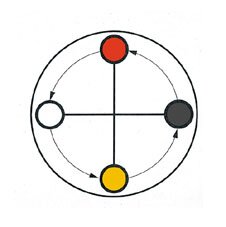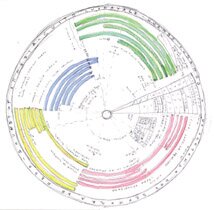




This work focuses primarily on the Kongo cosmogony, philosophies and theology originating from Central Africa that underlie a graphic expression system used particularly in Angola, the Caribean and South America. This knowledge has been disseminated throughout the Atlantic in the last several hundreds of years and has had a great influence in many of today's musical forms and styles. The particular vision behind the golian modes draws on the developments carried out in previous projects by Victor Gama in Angola, Portugal, Cuba, Brazil and Colombia such as Naloga, Odantalan and Tsikaya.
BRIEF DESCRIPTION OF THE GOLIAN MODES
The Golian modes are four musical modes derived from the ancient Kongo/Angolan graphic writing system known as "Bidimbu". The basis of the Golian modes are the fundamental cosmogram known as "Dikenga", which is represented beside, and the concept of "N'kizy".
Dikenga is a cosmogram considered crucial to Kongo cosmogony in that it, as described by Kongo scholar Bunzeki Fu Kiau, represents the conception of all living beings in the universe. Beyond merely representing all life in the universe, Dikenga is itself the energy of the universe, the force of all existence and creation. Like a compass, the basic aesthetic structure of Dikenga entails four cardinal points at the tips of two lines arranged in cross formation.1
A N'kizy is an object that contains meaning. It is a container of meaning through which one establishes communication. Scholars say that the concept of N'kizi represents a miniaturization of the world in certain kinds of religious objects . Figuratively, the N'kizi represents all of the power of the earth in miniature.
Miniaturizing the world is a means by which to simplify and condense the earth without changing the value to get better harmony and understanding, and control the feelings and emotions for world comprehension and protection.
The golian modes in music are connected to both the cyclical nature of life and the cosmos as manifested by the dikenga, and to an object that serves the purpose of mediator of dialogue, harmony and understanding. As a result, a score written in one of the golian modes has necessarily a 3D component, which is an object through which the composer communicates in musical form.
This theory therefore forms the basis of the Pangeia Instrumentos project and all of its instruments.
1 Barbaro Martinez-Ruiz